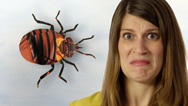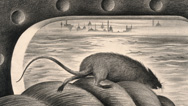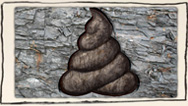Ancient Cataract Surgery
- By Anna Rothschild
- Posted 09.24.15
- NOVA
Doctors have attempted to remove cataracts for thousands of years, and the results weren't always pretty. In this episode of Gross Science, learn about the history of cataract surgery, and the safer and more effective methods doctors use today.
Transcript
Ancient Cataract Surgery
Posted: September 24, 2015
Lots of people get cataracts in their eyes as they age. And for most of human history, surgeons couldn’t really help... But that didn’t stop them from trying.
I’m Anna Rothschild, and this is Gross Science.
The lens of your eye is a clear structure that sits just behind the iris and helps focus the light coming in. But sometimes the aging proteins in the lens clump together and form a white spot. This is a cataract, and it makes your vision cloudy. This happens to more than half of Americans by the time they turn 80, and it’s not a new phenomenon. Surgeons started operating on cataracts thousands of years ago—long before they knew what the lens even did. And before anesthesia. So patients could feel every slice and jiggle.
An early description of cataract surgery comes from the Indian doctor Sushruta, over 2500 years ago. First, he said, use a sharp tool to poke into the eyeball. Then, sprinkle the eye with breast milk. The last step is a little unclear, but while the patient blows air out of one nostril, the doctor should attempt to either remove the lens or push it down into the eyeball.
Dislodging the lens and pushing it into the eye is called “couching.” And doctors in many countries throughout the ancient world practiced it. You might think the surgery became so popular because it worked well—but you’d be wrong. Couching did let light back into people’s eyes. But because it left their lenses out of place, their vision was completely unfocused. They often went blind from the procedure, assuming they didn’t first die of infection.
Believe it or not, couching is still performed in some countries in the developing world. But today, most people with cataracts are lucky to have some better options. Surgeons can use a tiny incision of just two or three millimeters to reach the cloudy lens and break it up with ultrasound before removing it. Then they can slide in a brand-new lens.
Interestingly, the first artificial lenses were inspired by World War II fighter pilots. Sometimes shrapnel from shattered windshields got lodged in these pilots’ eyeballs. A British eye doctor realized that the windshield bits could stay in their eyes without a problem, so he used the same material to build the first replacement lenses. So now, when patients have cataract surgery, they can actually see afterwards.
Eyeballs are gross... Ew.
Credits
PRODUCTION CREDITS
- Host, Animator, Editor
- Anna Rothschild
- Writer
- Elizabeth Preston
- DP, Sound
- Ceri Riley
- Gulag Archipelago
- Composed and Performed by
Tim Cahill and Benjamin Ouellette
IMAGES AND VIDEO
- Cataract in human eye
- Wikimedia Commons/Rakesh Ahuja, MD
- WMS 990 Monk performing eye operation Wellcome L0041072
- Wikimedia Commons/Wellcome Images
- Augenoperation 1195
- Wikimedia Commons/British Library MS Sloane 1975, f. 93.
- Couching for cataract. Wellcome L0021165
- Wikimedia Commons/Wellcome Images
- Operation for Cataract. Wellcome M0007416
- Wikimedia Commons/Wellcome Images
- Operation on the eye Wellcome M0007426
- Wikimedia Commons/Wellcome Images
- Sustruta. Pen drawing. Wellcome V0006619
- Wikimedia Commons/Wellcome Images
- Navy Fighter Pilots Aboard a British Aircraft Carrier. 4 January 1943, Aboard HMS Formidable. A14193
- Wikimedia Commons/Imperial War Museums, Roper F G (Lt)
- Whirlwindfighterproject FA 18181s
- Wikimedia Commons/Royal Air Force official photographer
- Cataract Surgery
- Pond5/sheyno
SFX
- Cockroaches
- Freesound/StateAardvark
(used with permission from author) - Squeak Pack/squeak_10
- Freesound/Corsica_S
- Produced by WGBH for PBS Digital Studios
POSTER IMAGE
- Operation for Cataract. Wellcome M0007416
- Wikimedia Commons/Wellcome Images
Sources
Want more info?
Facts About Cataracts from the National Eye Institute:
https://nei.nih.gov/health/cataract/cataract_facts
More on Sushruta:
http://www.ncbi.nlm.nih.gov/pmc/articles/PMC3039177/
http://bjo.bmj.com/content/59/3/171.full.pdf
Couching in the Modern World:
http://www.ncbi.nlm.nih.gov/pmc/articles/PMC3743109/
More on the development of the first replacement lenses:
http://bjo.bmj.com/content/85/9/1022.full
Sawbones Podcast on Cataracts:
http://www.maximumfun.org/sawbones/sawbones-cataracts
Related Links
-

Gross Science
Bizarre stories from the slimy, smelly, creepy world of science.
-

What is the Black Plague?
Plague sounds like a medieval disease, but there are a few cases in the US every year.
-

16th Century Nose Jobs
Thinking about getting a nose job? Thank goodness it's not the 16th century.
-

Hidden Secrets of Poop Fossils
Fossilized poop, called coprolites, can reveal surprising secrets about the past.

